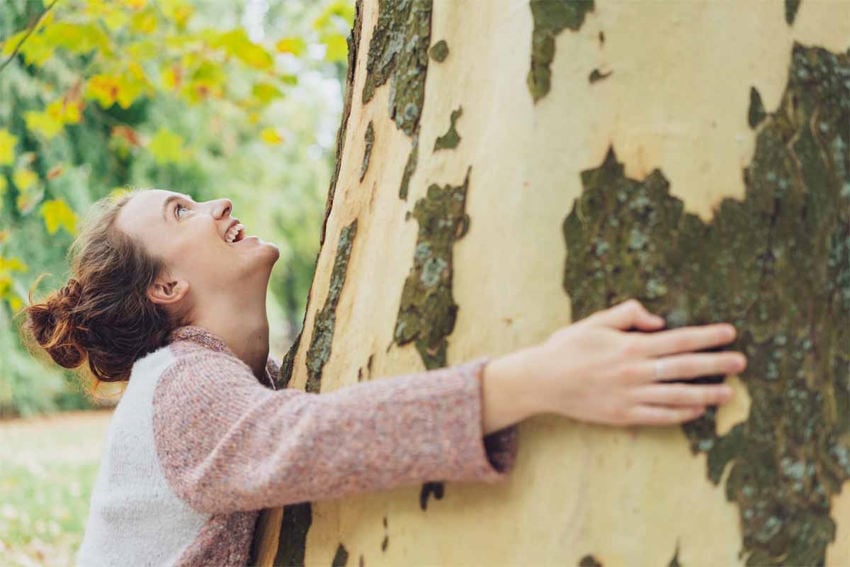
The citizens of Iceland have been encouraged by the forestry service to hug trees every day for five at least minutes. This is being encouraged to help people cope with social isolation, but does it really work? In this post, we will look at research showing the surprising benefits of hugging trees and explore why tree-hugging really can make you feel better.
In response to the challenges of social isolation and social distancing due to COVID-19, Iceland’s Forestry Service has encouraged tree-hugging. Physical contact with others has been discouraged whether we are socially distancing or socially isolating.
However, this prolonged physical separation can be psychologically challenging. The lack of hugs and physical touch can intensify feelings of separation, isolation, and loneliness. Iceland’s response? Hug trees!
Icelanders are being recommended to hug a tree for at least 5 minutes. The experience of hugging a tree has been described as a visceral feeling. As you hug the tree, a sensation travels through your toes and up through your body all the way up to your head. Rangers from the Hallormsstaður National Forest have cleared snow and marked out 2-meter spaces to help.
Humans are intimately connected to nature. This is an idea that has persisted across cultures and throughout the history of time. This is reflected by the idea that we all tend to prefer countryside views to urban ones.
Similarly, 100s of studies have found that experiencing nature has a positive effect on our physical and mental wellbeing. Other studies also show that people with pets tend to be happier.
Nature and images of nature often inspire feelings of awe. Piff et. al.’s study found that this sense of awe changes our sense of self and reduces barriers we feel between ourselves and others. The positive emotions we get from nature have also been shown to foster altruistic behavior even when briefly experienced.
On the other side, Louv’s “Last Child in the Woods” study hypothesizes that depression and anxiety are fuelled by a disconnect with nature they term a “nature-deficit disorder”.
Other studies have shown the numerous and wide-ranging benefits of a connection to nature. For example:
As we have outlined, getting out into nature, being surrounded by it, or simply viewing it can have psychological and physical benefits. Getting up close and personal only serves to accentuate these effects. This has long been known in Japan, where the national health program has offered forest bathing since 1982.
Known as shinrin-yoku, forest bathing has been found to reduce blood pressure, improve memory and concentration, and lower cortisol levels. Rather than simply strolling through a forest, it involves shedding all devices and mindfully spending time under the tree’s canopies. Typically, this would last at least 3 hours. However, the close contact of hugging a tree for 5 minutes makes mindful practice somewhat easier.
Breathe in the smells, feel the way the tree presses against you, feel its energy, and listen to the sounds. Some studies have suggested that forest bathing and tree-hugging might even work because of chemicals the tree emits. Known as phytoncides, these chemicals may have physiological effects that explain why hugging trees and immersing yourself in nature can be beneficial for your health.
There are numerous ways you can seek to benefit from increased engagement with nature, whether that involves hugging trees or not. Here, we outline some of the different ways you can increase your connectedness to nature from the small to the big:
During the time of social distancing, we should be careful to avoid emotional distancing. Fortunately, Iceland’s forestry service might just have cracked how we can all feel more connected.
More and more studies reveal the benefits of feeling connected with nature, and tree-hugging is just one example. Simply seeing it more can improve our well-being, both physically and psychologically. However, when we get up close and hug a tree, the benefits can be even greater. Give it a go and see what it can do!
View Comments
Hi Everyone,
I do not live in Iceland and am not planning on taking the advice of hugging a tree for up to 5 minutes a day, I remember last time we were given this advise and it is one thing just hugging a tree, but who can leave it there? So every day I go and hug the same tree and we gradually started to build up feelings for one another and over time it blossomed in to quite an intense relationship, and then one day just as was rounding the corner and she came in to view I saw somebody else hugging her! I was heartbroken, but she said that it had been going on for months with guys and girls; how did I let such a slutty tree capture my heart? In the end she said that it was not going anywhere and that she had "commitment" issues.
I told her that I wood find someone else!